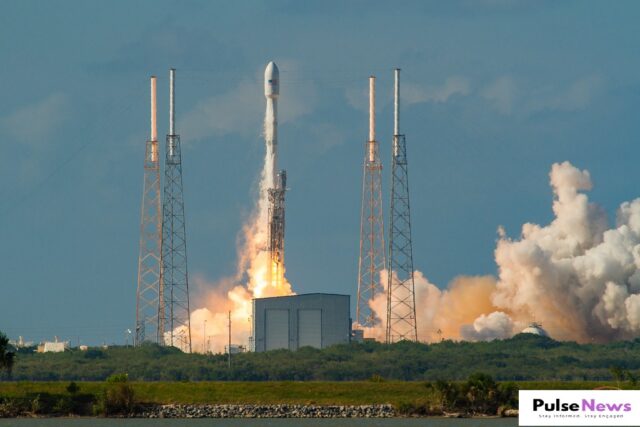On November 19, SpaceX made significant strides in space exploration, launching its massive Starship rocket from Boca Chica, Texas. This mission marks another key step toward advancing the Starship’s spaceflight capabilities, designed to eventually carry astronauts to the Moon and Mars.
Notably, U.S. President-elect Donald Trump watched the launch from SpaceX’s rocket facilities, signaling his growing relationship with Elon Musk and his companies.
Starship Launch Success, Despite Booster Landing Failure
At 4 p.m. CT (2200 GMT), SpaceX’s 400-foot-tall Starship rocket system soared into the sky, with the first stage booster, known as Super Heavy, detaching at 40 miles (62 km) in altitude. However, the booster missed its planned landing attempt on the tower, instead splashing down in the Gulf of Mexico.
SpaceX had hoped to catch the booster with large mechanical arms on the launch tower, a process demonstrated successfully in a previous test. The unexpected diversion to water was a setback, and a dramatic explosion occurred when the booster hit the Gulf, as captured in a separate live stream.
Despite this, the rest of the mission was a success. Starship completed its journey around Earth, performing a daytime splashdown in the Indian Ocean an hour later.
For the first time, Starship reignited one of its onboard engines during flight, demonstrating its maneuverability in space—something that had failed in previous test flights. This engine reignition marks a significant milestone for the reusable rocket system.
Musk’s Ambitious Goals and SpaceX’s Progress
Elon Musk, who previously highlighted the booster’s “faster and harder” landing attempt on social media, acknowledged the failure but also pointed to several successful outcomes.
This test flight demonstrated Starship’s increased capabilities, including better engine performance, efficient heat management during reentry, and a clearer splashdown in daylight. Musk noted that, in addition to these key tests, thousands of small design changes were made to improve the system’s functionality.
The launch took place just over a month after SpaceX’s previous test flight and was marked by the rapid approval of the Federal Aviation Administration (FAA). Musk has long criticized the FAA’s regulatory processes, but this quick approval was a positive sign of a developing partnership as the U.S. space industry grows.
Trump’s Support for SpaceX and Growing Influence of Musk
Trump’s presence at the launch is a clear signal of his ongoing alliance with Musk. The billionaire entrepreneur has been a vocal supporter of Trump’s presidential campaign and has backed the President-elect’s policies.
Musk’s influence is expected to increase under Trump’s administration, particularly with new projects like a government efficiency initiative, where Musk was recently appointed co-leader. This move is designed to reduce government waste and overregulation, issues Musk has often addressed as hurdles in SpaceX’s efforts to reach Mars.
NASA’s Artemis Program and SpaceX’s Future
Looking ahead, SpaceX’s Starship program is expected to align closely with NASA’s Artemis program. While Artemis aims to return astronauts to the Moon, Musk has consistently focused on the more ambitious goal of landing humans on Mars.
As part of this effort, Musk’s SpaceX will likely play a crucial role in the upcoming years, with advancements in Starship technology expected to accelerate. SpaceX President Gwynne Shotwell hinted at this accelerated timeline, predicting that Starship could surpass 400 launches in the next four years, mirroring the company’s workhorse Falcon rocket.
Regulatory Challenges and the Road to Mars
Despite regulatory challenges, SpaceX’s ability to streamline its approval process for Starship launches is a testament to the growing partnership between private companies like SpaceX and government agencies.
Musk has frequently expressed frustration with the pace of regulation in the commercial space sector, but the FAA’s recent approval of Starship’s latest test flight demonstrates the agency’s willingness to adapt to the rapid advancements of the U.S. space industry.
The Future of Space Exploration with Starship
The continued success of SpaceX’s Starship program signals that humanity is one step closer to reaching Mars. With advancements in reusable rocket technology, efficient space travel, and Musk’s determination, the vision of putting humans on Mars is gradually becoming more achievable.
As SpaceX works to refine Starship’s design and functionality, its missions will lay the foundation for the future of space exploration, furthering collaboration between private enterprises and government space agencies.
In the coming years, SpaceX’s ambitious goals will likely accelerate, bringing us closer to an era of commercial space travel, lunar bases, and the long-term goal of settling Mars. As part of this journey, the collaboration between Elon Musk, SpaceX, and the Trump administration will continue to shape the future of space exploration.











